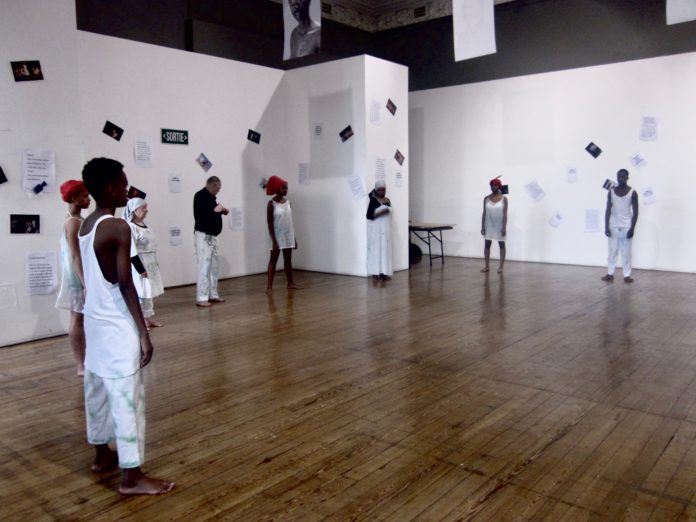OBISIKE: It Takes A Lion’s Heart
This performance, the result of an international collaboration between Germany and Nigeria, highlighted the similarities between cultures on the theme of women’s rights and questions of self-determination.

Strips of paper hung on strings across the stage which the women gradually pulled off piece by piece. Kirstin Hess, the Dramaturg, told me that they had used this gripping, repetitive action to symbolise the pressures of bureaucracy – specifically the horrific amount of paperwork that the cast had needed to complete when applying for the relevant visas to enable this international collaboration. Hess commented, “According to our countries, we should not come together. But we wanted to work together”. After much determination and paperwork, the women managed to work together successfully – such unity was symbolised onstage by the pieces of paper transforming into paper doves at the end of the piece.
“According to our countries, we should not come together. But we wanted to work together” – Kirstin hess
Indeed, the symbols and images in this piece seemed to me to tell more of a story than the spoken words – which were a fusion of different languages. Gregory Caers, the Dusseldorf-based Director of the production, commented that, “Sometimes [in life] you have to run and when you fall you have to get up again […] this struggle I’ve tried to make into a physical translation”. Certainly, my experience of seeing the characters struggle through their physicality (running and falling onto the stage, for instance) evoked a much stronger emotional reaction in me than if the characters had simply described their struggle using words. This use of physicalised storytelling was, therefore, a truly great example of theatre being able to bring audience members together regardless of the language they may speak.
young@home
The collaboration between Hillbrow Theatre (South Africa) and C:NTACT (Denmark), saw an ensemble of young cast members coming together who felt that their stories needed telling.
“If you have a story and you keep it to yourself, you have a thing that makes you go back. When you tell your story, you feel free and know that you are not alone” – Lihlithemba Ngcobo, Cast Member
What was fascinating to me about Gcebile Dlamini’s direction was the way in which these stories were told.
Coming from several different townships in Johannesburg, the cast communicated in their four different mother tongues: English, isiZulu, isiXhosa and Tshivenḓa. Telling stories in this way seemed an effective way of creating very raw and emotional responses from audience members. I reflected that such authenticity in performance may not have been possible if they had been translated into one common language.
On the walls of the Performance Space were personal comments about what ‘home’ meant to some of the cast members. These words surrounded the audience and, whilst they remained unspoken, they felt very pertinent to the unfolding performance – a beautifully unique feature of a truly compelling performance.
Forming a Dance for Young Audiences Network
 Whilst there may be multiple languages used to speak of Dance cultures, histories and traditions, the physicality of Dance has the potential to bridge across linguistic divides.
Whilst there may be multiple languages used to speak of Dance cultures, histories and traditions, the physicality of Dance has the potential to bridge across linguistic divides.
Such was the premise of this networking event, which aimed to create a platform both to identify possible opportunities for collaboration and, more generally, to energise the field of Contemporary Dance.
If you are an Artist involved in Contemporary Dance for Young Audiences and are interested in collaboration opportunities with the network, you can find more information here.









